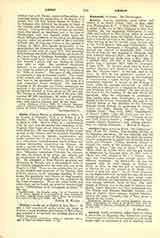

Ammon (Egyp., Amun or Amen, “the hidden one”. Heb. ‘Amen, Hebrew: ‚ÄòAmon Gr. ‚ÄòAmmon). The supreme divinity of the Egyptian pantheon. He was originally only the chief god of the city of Thebes, but later his worship became predominant in Egypt and extended even to Lybia and Ethiopia. Thebes, however, always remained the center of his worship, whence it was called Ne Amun, “the city of Amun”, Heb. No’-‘Amen (Nah. iii, 8, Heb. text), and the god himself is designated by Jeremias (xlvi, 25, Heb. text) as ‘Amen min Na’, Ammon of No, i.e. Thebes. Ammon was worshipped under several names with different attributes. As Ammon-Ra, he was the sun-god, with his chief temple at Thebes; as Khem or Min, he was the god of reproduction; as Khnum, he was the creator of all things, “the maker of gods and men”. In the latter character he was represented with the head of a ram, the animal sacred to him, or simply with ram’s horns; under this form Ammon was best known to classical writers, who always attribute horns to him. The chief temple of Khnum was in the oasis of Ammon (now Siwah), where Alexander the Great worshipped him. The Greeks and Romans identified Ammon with Zeus or Jupiter (Zeus Ammon, Jupiter Ammon), whence the name Diospolis, City of Zeus, given to Thebes by the Greeks.
F. BECHTEL

